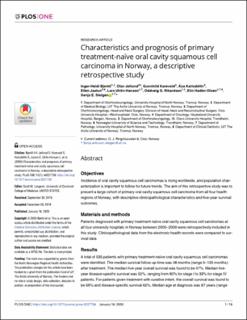| dc.contributor.author | Bjerkli, Inger-Heidi | |
| dc.contributor.author | Jetlund, Olav | |
| dc.contributor.author | Karevold, Gunnhild | |
| dc.contributor.author | Karlsdottir, Åsa | |
| dc.contributor.author | Jaatun, Ellen A. Andreassen | |
| dc.contributor.author | Uhlin-Hansen, Lars | |
| dc.contributor.author | Rikardsen, Oddveig G | |
| dc.contributor.author | Hadler-Olsen, Elin Synnøve | |
| dc.contributor.author | Steigen, Sonja Eriksson | |
| dc.date.accessioned | 2020-06-11T07:47:34Z | |
| dc.date.available | 2020-06-11T07:47:34Z | |
| dc.date.created | 2020-05-05T09:28:45Z | |
| dc.date.issued | 2020 | |
| dc.identifier.citation | PLoS Medicine. 2020, 15(1): e0227738, . | en_US |
| dc.identifier.issn | 1549-1277 | |
| dc.identifier.uri | https://hdl.handle.net/11250/2657645 | |
| dc.description.abstract | Objectives
Incidence of oral cavity squamous cell carcinomas is rising worldwide, and population characterization is important to follow for future trends. The aim of this retrospective study was to present a large cohort of primary oral cavity squamous cell carcinoma from all four health regions of Norway, with descriptive clinicopathological characteristics and five-year survival outcomes.
Materials and methods
Patients diagnosed with primary treatment-naïve oral cavity squamous cell carcinomas at all four university hospitals in Norway between 2005–2009 were retrospectively included in this study. Clinicopathological data from the electronic health records were compared to survival data.
Results
A total of 535 patients with primary treatment-naïve oral cavity squamous cell carcinomas were identified. The median survival follow-up time was 48 months (range 0–125 months) after treatment. The median five-year overall survival was found to be 47%. Median five-year disease-specific survival was 52%, ranging from 80% for stage I to 33% for stage IV patients. For patients given treatment with curative intent, the overall survival was found to be 56% and disease-specific survival 62%. Median age at diagnosis was 67 years (range 24–101 years), 64 years for men and 72 years for women. The male: female ratio was 1.2. No gender difference was found in neither tumor status (p = 0.180) nor node status (p = 0.266), but both factors influenced significantly on survival (p<0.001 for both).
Conclusions
We present a large cohort of primary treatment-naïve oral cavity squamous cell carcinomas in Norway. Five-year disease-specific survival was 52%, and patients eligible for curative treatment had a five-year disease-specific survival up to 62%. | en_US |
| dc.language.iso | eng | en_US |
| dc.publisher | PLOS, Public Library of Science | en_US |
| dc.rights | Navngivelse 4.0 Internasjonal | * |
| dc.rights.uri | http://creativecommons.org/licenses/by/4.0/deed.no | * |
| dc.title | Characteristics and prognosis of primary treatment-naïve oral cavity squamous cell carcinoma in Norway, a descriptive retrospective study | en_US |
| dc.type | Peer reviewed | en_US |
| dc.type | Journal article | en_US |
| dc.description.version | publishedVersion | en_US |
| dc.source.pagenumber | 16 | en_US |
| dc.source.volume | 15 | en_US |
| dc.source.journal | PLoS Medicine | en_US |
| dc.source.issue | 1:e0227738 | en_US |
| dc.identifier.doi | https://doi.org/10.1371/journal.pone.0227738 | |
| dc.identifier.cristin | 1809365 | |
| dc.description.localcode | Copyright: © 2020 Bjerkli et al. This is an open access article distributed under the terms of the Creative Commons Attribution License, which permits unrestricted use, distribution, and reproduction in any medium, provided the original author and source are credited. | en_US |
| cristin.ispublished | true | |
| cristin.fulltext | original | |
| cristin.qualitycode | 2 | |

